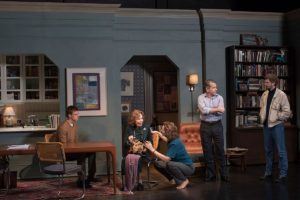 It’s been close to 60 years since Elaine May has officially headlined on Broadway, the last time in tandem with Mike Nichols, her partner in comedy. (Yes, there was Jerome Robbins’ The Office, in 1966, but that closed in previews.) She had other things to do: writing movies (like 1978’s Heaven Can Wait and 1998’s Primary Colors, for which she received Oscar nominations), directing movies (four, all of them worthwhile, including, yes, 1987’s Ishtar), and occasionally acting in them, most recently Woody Allen’s Amazon show Crisis in Six Acts (2016). But she’s done them sparingly, acquiring a Garbo-ish allure along the way. (A funny Garbo.)
It’s been close to 60 years since Elaine May has officially headlined on Broadway, the last time in tandem with Mike Nichols, her partner in comedy. (Yes, there was Jerome Robbins’ The Office, in 1966, but that closed in previews.) She had other things to do: writing movies (like 1978’s Heaven Can Wait and 1998’s Primary Colors, for which she received Oscar nominations), directing movies (four, all of them worthwhile, including, yes, 1987’s Ishtar), and occasionally acting in them, most recently Woody Allen’s Amazon show Crisis in Six Acts (2016). But she’s done them sparingly, acquiring a Garbo-ish allure along the way. (A funny Garbo.)
At 86, she’s returned to the stage, the very same one she shared with Nichols, undiminished–except for the Alzheimer’s that torments her, and her deeply concerned family, in Kenneth Lonergan’s The Waverly Gallery, which is making its Broadway debut. It’s something of a shock to see her, bent and frail. Yes, she’s acting, but enacting a phase, and a trauma, that all of us must go through. Other plays that have dealt with this subject, like The Father with Frank Langella, have dramatized the fading, foggy consciousness of the main character, as the sets and supporting players disappear and reappear on stage. The decline of Gladys Green, a once-feisty activist who runs a nondescript gallery adjacent to a Greenwich Village hotel, is here witnessed by those closest to her. Her grandson, Daniel (Lucas Hedges, the Oscar-nominated co-star of Lonergan’s Manchester by the Sea), who lives next door to her apartment, bears much of the burden as she gradually slips away.
 Lonergan based the play on his travails with his grandmother, and it’s an unsentimental portrait, marvelously incarnated by his star–a cutesy old lady she’s not. (Eileen Heckart played Gladys Off Broadway, in 2000.) There’s a terrible humor throughout, as Gladys struggles with words and concepts that are suddenly alien to her, while Daniel, her daughter Ellen (Joan Allen), and Ellen’s second husband Howard (Tony-winning director David Cromer) struggle to sort her out without institutionalization. Meanwhile, the never-successful gallery wilts to gentrification, as Gladys’ latest untalented artist, Don (Michael Cera, the playwright’s good luck charm in his prior Broadway revivals of This Is Our Youth and Lobby Hero), settles in for its final show. Lila Neugebauer directs this uniformly fine cast simply; there are no histrionics, and no tugging at the heartstrings. If tears do flow, it’s in seeing a common, frustrating situation so reenacted so lucidly, on David Zinn’s perfectly realized, naturalistic sets, accompanied in scene changes by Tal Yarden’s projections of the neighborhood through Gladys’ decades.
Lonergan based the play on his travails with his grandmother, and it’s an unsentimental portrait, marvelously incarnated by his star–a cutesy old lady she’s not. (Eileen Heckart played Gladys Off Broadway, in 2000.) There’s a terrible humor throughout, as Gladys struggles with words and concepts that are suddenly alien to her, while Daniel, her daughter Ellen (Joan Allen), and Ellen’s second husband Howard (Tony-winning director David Cromer) struggle to sort her out without institutionalization. Meanwhile, the never-successful gallery wilts to gentrification, as Gladys’ latest untalented artist, Don (Michael Cera, the playwright’s good luck charm in his prior Broadway revivals of This Is Our Youth and Lobby Hero), settles in for its final show. Lila Neugebauer directs this uniformly fine cast simply; there are no histrionics, and no tugging at the heartstrings. If tears do flow, it’s in seeing a common, frustrating situation so reenacted so lucidly, on David Zinn’s perfectly realized, naturalistic sets, accompanied in scene changes by Tal Yarden’s projections of the neighborhood through Gladys’ decades.
Memory plays like this one are difficult to get right, and I must say that Hedges was a bit tentative in his narration. By now, though, I’m sure he’s settled in, and the ensemble is humming along. The Waverly Gallery is redolent of family, at its most embattled. “It’s no fun getting old!” cries Howard, who’s always trying to defuse a situation that the more reserved Ellen wants to keep a lid on. “Nobody wants to hear that!” Gladys responds in protest. But to watch Elaine May rage against the dying of the light makes for splendid viewing.





Comments